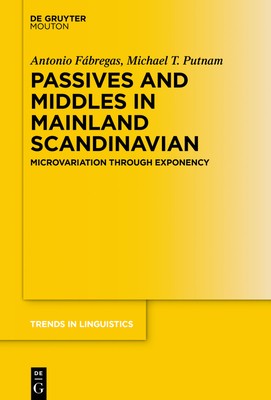
- We will send in 10–14 business days.
- Author: Antonio Fábregas
- Publisher: Walter de Gruyter
- ISBN-10: 311063371X
- ISBN-13: 9783110633719
- Format: 15.6 x 23.4 x 1.8 cm, hardcover
- Language: English
- SAVE -10% with code: EXTRA
Reviews
Description
This monograph explores the properties of passive and middle voice constructions in Norwegian and Swedish, concentrating on the linguistic variation related to these two constructions in Mainland Scandinavian. At an empirical level, we provide a detailed discussion of the morphosyntax and semantics of the two main types of passives in both languages, lexical (s-) and periphrasitic (bli-) passives. At a theoretical level, we propose an architecture of the language faculty where exponents play a central role. Exponents are selected to identify the structures generated by the grammar and provide a platform that make these units interpretable by the sensori-motor and conceptual-intentional interfaces. Exponents this play an essential role in determining the well-formedness of linguistic structures. We demonstrate how different syntactic structures identified and lexicalized by exponents in these two languages are capable of capturing the microvariation observed in the voice systems of these two languages in a straightforward way. The amount of linguistic information (i.e., aspect and mood) identified by each exponent in each language determines the types of complements and specifiers that can be integrated into and lexicalized by a given exponent. Although our approach shares certain affinities with other neo-constructionist approaches, a novel proposal we advance in this book is that exponents are housed in an intermediate level of structure that exists between the narrow syntax and its external interfaces. This exponency-level (Ʃ-structure) allows for a more parsimonious theoretical analysis that does not sacrifice descriptive adequacy.
EXTRA 10 % discount with code: EXTRA
The promotion ends in 12d.11:30:34
The discount code is valid when purchasing from 10 €. Discounts do not stack.
- Author: Antonio Fábregas
- Publisher: Walter de Gruyter
- ISBN-10: 311063371X
- ISBN-13: 9783110633719
- Format: 15.6 x 23.4 x 1.8 cm, hardcover
- Language: English English
This monograph explores the properties of passive and middle voice constructions in Norwegian and Swedish, concentrating on the linguistic variation related to these two constructions in Mainland Scandinavian. At an empirical level, we provide a detailed discussion of the morphosyntax and semantics of the two main types of passives in both languages, lexical (s-) and periphrasitic (bli-) passives. At a theoretical level, we propose an architecture of the language faculty where exponents play a central role. Exponents are selected to identify the structures generated by the grammar and provide a platform that make these units interpretable by the sensori-motor and conceptual-intentional interfaces. Exponents this play an essential role in determining the well-formedness of linguistic structures. We demonstrate how different syntactic structures identified and lexicalized by exponents in these two languages are capable of capturing the microvariation observed in the voice systems of these two languages in a straightforward way. The amount of linguistic information (i.e., aspect and mood) identified by each exponent in each language determines the types of complements and specifiers that can be integrated into and lexicalized by a given exponent. Although our approach shares certain affinities with other neo-constructionist approaches, a novel proposal we advance in this book is that exponents are housed in an intermediate level of structure that exists between the narrow syntax and its external interfaces. This exponency-level (Ʃ-structure) allows for a more parsimonious theoretical analysis that does not sacrifice descriptive adequacy.


Reviews